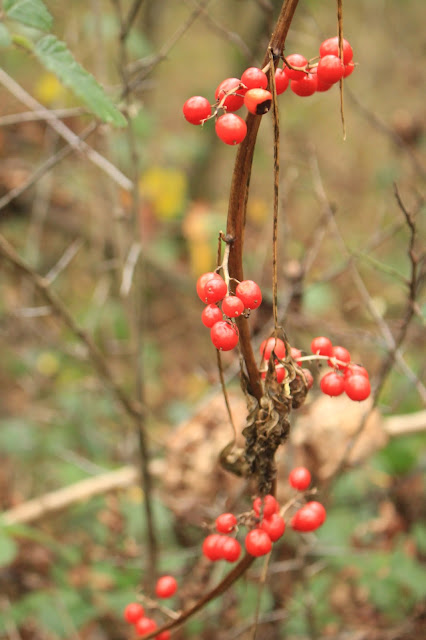A few weeks ago, after a long day at work, I came home to a
very exciting surprise in my porch. It was in a satisfyingly thick and heavy
brown envelope, making it clear that it wasn’t just my regular run-of-the-mill
post. I eagerly opened it up and found that my Mum had bought me a Wildlife
Trust membership as an early Christmas present. Inside was a plethora of
exciting booklets, showing all the reserves in the area, and as it turns out
there are far more than I knew about. So armed with lots of new places to
explore, we decided to get straight outside that weekend and discover a new
local gem – Brampton Woods!
At just over 130 hectares, Brampton Woods is
Cambridgeshire’s second largest woodland. When we first visited, despite it
being very late autumn, a surprising number of trees still retained green
leaves. These were juxtaposed with the vast array of brilliantly coloured
autumnal leaves which were either still hanging tentatively from their branches
or had dropped to form a cushioned carpet on the ground. The paths vary between
wide open rides for easy walking to slightly more meandering and bumpy tracks
for a feeling of rambling “off-piste”.
Now that the craziness of Christmas and New Year has passed,
we are back to our normal routine so decided to take the time today to revisit
Brampton to see how winter is treating it. Gone are the autumnal colours, now
the only green belongs to brambles and pines. But let’s not just focus on the
lack of leaves, there are so many other bright and beautiful things to see in
the woods at this time of year. Bright glistening crimson berries of
honeysuckle are omnipresent, sitting proudly on unrelated plants which the
honeysuckle has managed to entwine its way around and climb up. Glossy scarlet
rosehips also decorate the area, hanging tantalisingly like freshly polished
rubies from wild rose bushes. Then, of course, there is lichen: wonderful,
polychromatic, multi-textured lichen. This is like the woodland’s wallpaper. Bark
and rocks are transformed by the kaleidoscopic whites, greens, oranges and
yellows of this fascinating organism.
It is not just the plants which are a source of excitement
in winter. Brampton is frequented by multitudes of resident birds and winter
migrants, such as redwings and fieldfares. The woodland habitat is managed for
the benefit of nature, and from the impressive number of species that have been
recorded at the site it is clear that it is working. Perhaps most excitingly,
the woods are home to a number of dormice. This sleepy little mammal is
nocturnal and hibernates throughout the winter so you would be very lucky to
see one. Brampton Woods is a particularly special place for dormice because
they were only reintroduced here in 1993, and it was the first site in the UK’s
reintroduction programme. The woods are perfect for these indecently adorable
creatures – the vast variety of trees provides them with ample food sources,
from the hazelnuts and sloe berries that grow on the branches, to the insects
which crawl along the bark. Wandering through the woods, we spotted a number of
special dormouse nesting boxes hanging from trees; obviously it is important to
remember to marvel from afar because it is illegal to disturb a dormouse’s
nesting place.
This ancient woodland feels a million miles away from the
hustle and bustle of daily life. It has stood here for around 900 years,
witnessed people come and go, watched trends ebb and flow. It is a good
reminder of the permanence of the wonder of nature – a feeling that transcends
time and location.




